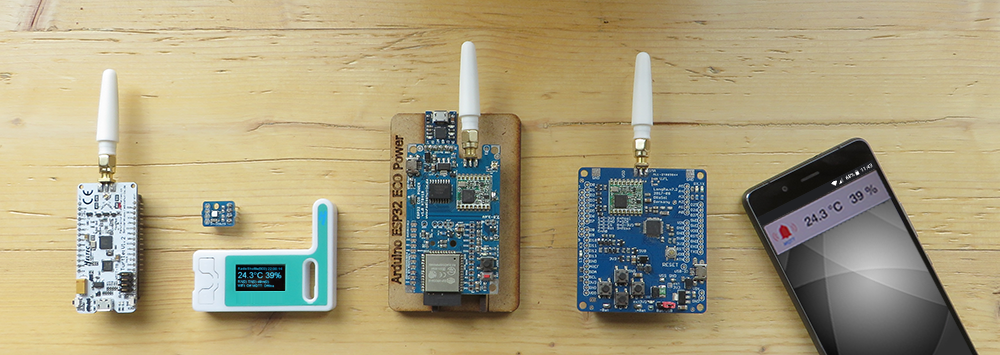The LoRa wireless technology allows sensors to communicate, in the free 868 MHz band, over large distances, from 200 m to 20 km. The LoRa technology excels with a very low energy requirement and a long range, and is suited for low data rates. There are different LoRa solutions which are usually based on a LoRa chip manufactured by Semtech.
LoRa: the basics
LoRa uses a special spread spectrum modulation. Basically, this type of modulation can be used throughout all frequencies; commonly used are the free 433 MHz and 868 MHz bands in Europe. The 868 MHz band is often used because it has less traffic and is better regulated, and therefore provides better radio conditions.
A standardized LoRaWAN protocol already exists. It requires a special concentrator and forwards the data to an Internet server. The concentrator, which is able to receive multiple channels at the same time, offers advantages when employed in large installations. However, the LoRaWAN protocol does not support direct peer-to-peer communication, and is too expensive and too complex for many applications.
We have developed a new LoRa wireless protocol software (“RadioShuttle”), which is capable of efficiently sending messages in a fast and secure way. This software is equally suitable as a node or as a station (server), and supports various LoRa chips (RFM95_SX1276, MURATA_SX1276, SX1276MB1MAS, SX1276MB1LAS).
LoRa: the modules
There are a large number of different modules that have an integrated LoRa wireless modem. However, most of these modules are distributed without software, and are therefore useless for users and developers.
General thoughts on the LoRa range
Many factors influence the range: antenna, walls, reinforced concrete ceilings, radio reflections, transmitters on identical frequencies, and much more. Hence, we are talking about a range of 200 m to 20 km, which is, compared to other LoRa wireless technologies, several times better.
868 MHz standard modulations (without LoRa), which are permitted to use up to 14 dBm transmitting power in Germany, have a range of approx. 50 meters in open spaces and reach just through a wall in buildings. On a practical level, the 868 MHz standard modulation causes reception problems even within an apartment.
We have done tests, using the 868 MHz LoRa modulation – also at 14 dBm of transmitting power, in which the reception worked in a tall building, even over nine floors. Further tests that were performed in a large room, with 5000 smartphones and many additional wireless transmitting technologies, revealed that the LoRa wireless technology worked like a charm. An essential advantage of LoRa is that the LoRa modulation also works superimposing on standard 868 MHz radio channels.
General thoughts on the LoRa modulation
The LoRa spreading factor
The spreading factor determines how many symbols are used to encode user data. This is specified for LoRa modulation from SF6 to SF12. For example, 128 symbols are used for SF7 and 2048 symbols for SF11 to encode the identical user data. SF7 is the standard spreading factor, which has a transmission delay of approx. 120 milliseconds for a data transmission of 64 bytes. With SF11, the delay is well over one second. In the summary:
Small spreading factor (e.g. SF7):
- Short transmission time
- 10 transactions per second possible
- Less power consumption
- Low range
- More nodes possible in the network
- Small radio cell
Large spreading factor (e.g. SF11):
- Long transmission time
- Only one transaction per second possible
- Significantly more power consumption (10x)
- Higher range
- Less nodes possible in the network
- Large radio cell
As a result, it can be said that the standard SF7 spreading factor offers many advantages, since simply more nodes work in a small radio cell and therefore foreign radio cells are not disturbed.
LoRa frequency bandwidth
The bandwidth for LoRa modulation can be specified, defined among others are 31.25 kHz, 41.7 kHz, 62.5 kHz, 125 kHz, 250 kHz, and 500 kHz. A smaller bandwidth requires considerably more time for message transmission. Bandwidths below 125 kHz only work with special LoRa hardware, which uses a TCXO (Temperature Compensated Crystal Oscillator) and has special hardware support for it. It works stably with all LoRa chipsets from 125 kHz and up. The LoRaWAN protocol supports only the 125 kHz bandwidth. The RadioShuttle protocol supports all bandwidths, but 125 kHz is also recommended.
The bandwidth is also important for channel selection: if, for example, the channel 868.1 MHz with a bandwidth of 125 kHz is used, the next free channel must be further away than the bandwidth. This means that 868.2 MHz does not work, 868.3 MHz would be the next free channel.
Range with different spreading factors
Below is a small overview of tested ranges with the standard bandwidth of 125 kHz and different spreading factors. In principle, considerably longer ranges are also possible. For example, SF7 can reach several kilometers without disturbances and clear visibility, SF11 can reach over 20 km. As buildings and other disturbances do not normally provide a perfect transmission, see below an overview of tested ranges in populated areas.
| Spreading factor | Transmission time 64 bytes (at a bandwidth of 125 kHz) | Tested range |
|---|---|---|
| SF7 | 120 ms | 100-500 m |
| SF8 | 220 ms | |
| SF9 | 390 ms | > 1 km |
| SF10 | 700 ms | |
| SF11 | 1320 ms | > 2 km |
| SF12 | 2470 ms |
